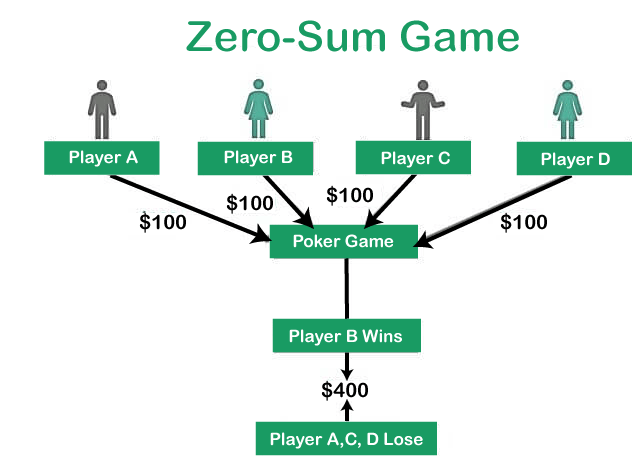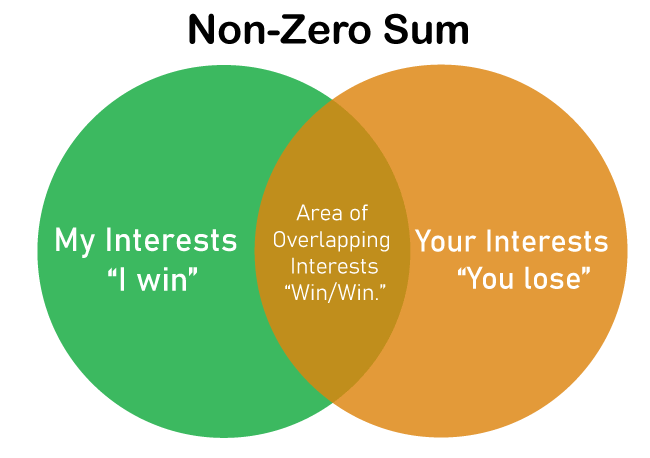Automata and Game TheoryIn this article, you will have great understanding of the role of Automata in Game Theory. Let us start the discussion with introducing -Game Theory". Introduction to Game TheoryThe study of decision-making in scenarios where the actions of multiple individuals or players determine the outcome is known as game theory, an interdisciplinary field of mathematics and economics. It is applied to simulate situations where strategic choices are made by players to achieve their goals while taking into account the decisions made by others. The concept of rational decision-making formed the basis of early economic behavior models developed by mathematicians like John von Neumann and Oskar Morgenstern in the early 1900s. Over time, game theory has emerged as a widely-used tool in various fields such as political science, psychology, computer science, and economics. The study of game theory involves examining formal models of strategic interactions between players. These models, called games, consist of a group of players, a range of actions each player can take, and a set of results that occur based on the actions taken. It is assumed that players in these games are rational and motivated by self-interest, always choosing the option that leads to the most favorable outcome for themselves. Game theory offers a method for analyzing the strategic decisions that players make in a game and for forecasting the resulting outcomes. Its applications have spanned many fields, such as analyzing market competition, voting patterns, international relations, and animal behavior. Basic Concepts in Game TheoryGame theory relies on a number of fundamental concepts that are utilized for modeling and assessing strategic interactions between different players. Among the most crucial concepts in game theory are the following:
These are only a handful of the fundamental ideas in game theory. In order to simulate and evaluate a wide range of strategic interactions between individuals and groups, from market rivalry to political discussions, game theorists use the notions mentioned above. Types of GameGame theory classifies games into different types based on their characteristics and rules. Here are some of the most common types of games:
Game theory covers a wide range of game types, as demonstrated by the examples mentioned. By analyzing these games and the strategies used by players, game theorists can gain insights into real-life situations such as market competition and social interactions. No information is left out when exploring these different types of games. Nash EquilibriumIntroductionJohn Nash, a mathematician who won the Nobel Prize, is honored with the name of the fundamental idea in game theory known as Nash Equilibrium. A collection of strategies, one for each player, is described as a solution concept for non-cooperative games in which no player has an incentive to unilaterally depart from their selected strategy in light of the strategies of the other players. In other words, Nash equilibrium is a situation in which, given the strategies of the other players, each player's plan is the best possible one. No player should alter their approach because doing so would make their own situation worse. Examples:Let's use a straightforward example to show how Nash equilibrium works. Consider a situation where A and B are two businesses vying for market share in a certain sector. They have the option of advertising or not. The following is the game's payout matrix: 
Depending on the decisions each firm makes, each number in the matrix indicates the reward (profit) for that company. As an illustration, if A advertises and B does not, then A makes a profit of three and B makes a profit of zero. When both businesses decide to advertise, the game reaches the Nash Equilibrium. If A advertises and B does not advertise, A will make no money and would much rather stop advertising. If B advertises and A does not, B will benefit by three and would rather stop promoting. The only predictable result is that both businesses will advertise. Applications:Several disciplines, such as economics, political science, and evolutionary biology, use Nash equilibrium. It is frequently employed in studying the strategic relationships between people, groups, and countries. We can forecast the most likely outcomes of a game and plan our strategies appropriately by comprehending the Nash Equilibrium. Formal Language and AutomataIntroduction to Formal Language Theory and Automata Theory:Formal language theory and automata theory are branches of computer science that deal with the study of formal languages and the computational models that recognize and generate them. These theories are concerned with the design and analysis of algorithms, programming languages, compilers, and other software systems. They are also applied in many other areas, such as natural language processing, artificial intelligence, and bioinformatics. Key Concepts:
Applications in Computer Science
Automata and Game TheoryAutomata can be very useful in game theory, particularly in the analysis of games where the strategies of the participants are interconnected. Systems that vary over time can be represented mathematically using automata. The strategies and choices made by players in a game are represented by automata in game theory. Games that can be modelled with automata include the following:
These are just a few examples of the kind of games that can be automated. In game theory, automata can be used to represent a broad variety of games and scenarios involving making decisions, including ones involving numerous players and intricate strategy. Finite Automata and Game TheoryThe basic of Finite Automata:Mathematical models known as finite automata (FA) include an initial state, a transition function, a finite collection of states, and a set of inputs. Games in game theory are among the many systems that can be modelled and examined using FA. 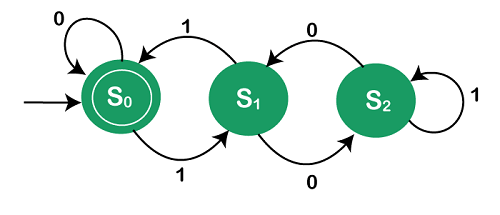
Applications of Finite State Machines in Game Theory:In game theory, FA are employed to simulate player actions and strategy. The inputs reflect the actions that players can do in each state, and the states of the FA indicate the various possible game situations. The transition function specifies the outcomes that follow from each combination of player actions and establishes the game's rules. Game theorists can forecast game results and pinpoint the best plays for each player by examining the FA's behavior. Here are some common applications of FA in game theory:
Some examples of games that can be modeled using FA include Tic-Tac-Toe, Rock-Paper-Scissors, and the Game of Life. In each of these games, the FA represents the different possible states of the game and the rules that govern player actions and outcomes. Pushdown Automata and Game TheoryThe role of pushdown automata in game theory:In game theory, pushdown automata are crucial, especially when modelling games using context-free grammars. An automaton with a stack that enables information storage and retrieval is referred to as a pushdown automaton (PDA). This makes it ideal for simulating games like chess and poker where players make decisions based on previous actions. 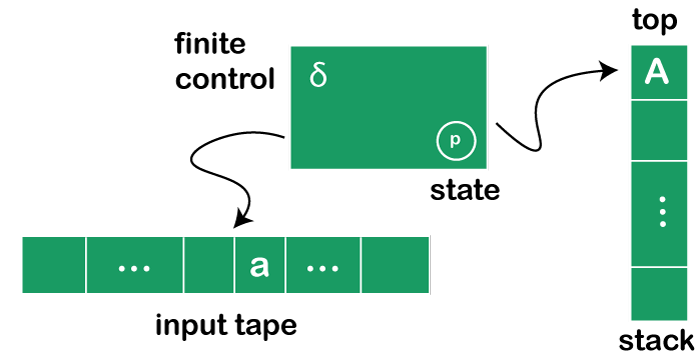
Modelling of Games with context free grammars:The game of poker is one example of a game that can be modelled with a PDA. Each poker player receives a hand of cards, and based on the situation of their hand and the cards on the table, they place bets. The beginning state of the game is the hand of cards dealt to each player, and each succeeding state is the outcome of that player's action, which can be visualized as a context-free grammar. The game of Nim is another illustration of a game that may be modelled with a PDA. Each player in the game Nim takes turns taking objects out of the various object piles. The piles' arrangement can be thought of as the game's beginning state and each succeeding state as the outcome of a player's action in a context-free grammar. PDAs can be helpful in game theory because they can employ context-free grammars to capture the recursive structure of games. The intricacy of the game, the best playing styles for each participant, and the game's potential outcomes can all be discovered by researchers by examining the PDA. PDAs can also be used to simulate the game, enabling researchers to evaluate various tactics and game configurations. Turing Machine and Game TheoryThe role of Turing machine in game theory:In game theory, Turing machines have been crucial, especially when it comes to modelling games using recursively enumerable languages. Turing machines are frequently employed to represent games with recursively enumerable language. A mathematical representation of a fictitious computer system that is capable of simulating any algorithmic procedure is known as a Turing machine. A Turing machine, in other words, can be used to describe any process that can be calculated by an algorithm. 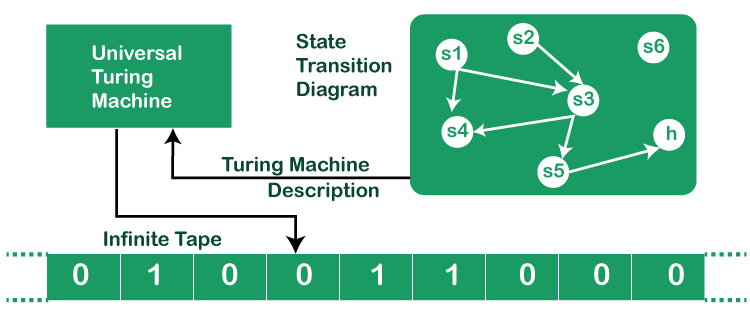
Modelling of Games with recursively enumerable languages:It is feasible to describe the entire game as a sequence of algorithmic stages using a Turing machine, with each step's outcome depending on the decisions made by the players and the steps before it. Take a chess game as an illustration. The game could be modelled using a Turing machine by describing each move as an algorithmic step, with the results of each step depending on the actions taken by the players and the preceding stages. It is feasible to examine player strategy and forecast game outcomes by modelling the game in this way. Automata Learning and Game TheoryThe role of Automata Learning in Game Theory:Automata learning has grown in significance as a tool in game theory, especially when it comes to using machine learning algorithms to understand the tactics of other players. The process of automatically determining a model of a system's behavior from observable inputs and outputs is known as automata learning. By examining their previous conduct and projecting their future behavior, automaton learning in game theory can be used to learn the strategies of other players in a game. The use of machine learning algorithms to learn the strategies of other players in a game:In game theory, reinforcement learning is a popular method for applying machine learning algorithms. An agent learns to operate in a way that maximizes a reward signal through reinforcement learning. This reward signal in a game might indicate a player's chances of winning or accomplishing another objective. The strategies of other participants in a game can be taught to agents via reinforcement learning algorithms. The agent can learn from other players' activities how they play and forecast what they will do next by observing how they behave. Game-theoretic algorithms are a different way to apply machine learning algorithms in game theory. These algorithms are made to make game decision-making as efficient as possible while taking into account the tactics used by other players and the possible results of certain actions. The imaginary play algorithm, for instance, assumes that each player is using a mixed strategy and calculates the distribution of each player's strategies based on their observed behavior. This is an example of a game-theoretic algorithm. The algorithm modifies its own strategy in order to maximize expected reward using this knowledge. Automata Learning and Game TheoryGame theory and automata are effective tools with applications in many disciplines, including economics, politics, and artificial intelligence.
Game theory and automata are effective tools with many diverse applications. Researchers and practitioners may model and analyze complicated systems, create effective algorithms, and learn how people and groups behave in various settings by using these tools. Future DirectionsThere are various potential future study avenues because automata and game theory are fields that are always developing. These are a few of the directions:
In conclusion, game theory and automata are significant fields of study with a wide range of prospective paths. Researchers may significantly impact sectors like economics, politics, engineering, and artificial intelligence by creating novel modelling techniques and using them to solve real-world problems. CONCLSUIONGame theory and automata are significant disciplines of research with numerous applications. Game theory studies how strategic decisions are made in competitive circumstances, whereas automata theory studies mathematical models of computing and communication. Together, these disciplines offer strong tools for simulating and analyzing complicated systems, creating effective algorithms, and learning about how people behave in various situations. Several fields, including economics, political science, engineering, and artificial intelligence, use automata and game theory. Automata and game theory have recently attracted more attention as tools for solving real-world issues and creating novel applications. In addition to researching how automata and game theory might be applied to multi-agent systems, researchers are also addressing complexity and scalability issues.
Next TopicRecursive Descent Parser
|
 For Videos Join Our Youtube Channel: Join Now
For Videos Join Our Youtube Channel: Join Now
Feedback
- Send your Feedback to [email protected]
Help Others, Please Share





